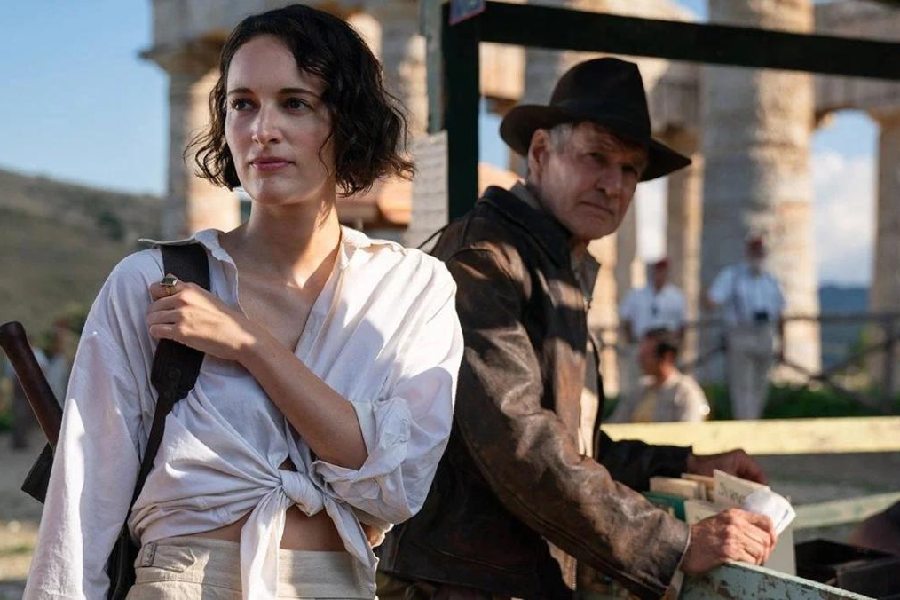The legendary John Williams’s booming Raiders March steals the show in the end credits of Indiana Jones and the Dial of Destiny. The rest of what comes before it? Not quite.
A massive nostalgia hook will undoubtedly pull in fans of the Indiana Jones franchise — as it did to me — to theatres this weekend for what is the swashbuckling adventurer’s final curtain call, with Harrison Ford, now 80, armed with the familiar whip and quip that has made Indiana Jones one of the most loved Hollywood franchises ever since Raiders of the Lost Ark roared into cinemas more than four decades ago.
Dial of Destiny does reward Indy’s fans and followers with references and hat tips, many of which will make you get back home and revisit at least the first three films of the franchise. The film has quite a few performative moments that longtime fans will appreciate and, for a large part, is an entertaining old-school sequel.
But James Mangold, taking over from Steven Spielberg, has too large a pair of shoes to fill. Indiana Jones’s last whip-cracking adventure, despite having high-octane chases, adrenaline-pumping action scenes and Harrison Ford’s evergreen charisma, lacks both the poise and panache that made the character, created by George Lucas as a homage to the action heroes of 1930s serials, such a standout hero. Mangold — whose filmography includes topline directing credits like Girl Interrupted, a few of the Wolverine films including the character’s swansong Logan, Walk the Line and Ford v Ferrari — is both competent and creative, but in bringing Lucas and Spielberg’s hero to life in this final instalment, the film-maker has clearly misunderstood the memo, or ignored it.
Indiana Jones, our very own Indy, is not a superhero. He is not Ethan Hunt, neither is he James Bond. His superpower lies in his wry, witty and sarcastic sense of humour, his deep knowledge of ancient civilisations and languages, and his ability to sense danger and snuff it out without hanging from a building or swinging from a tree (okay, he may have done that a few times, but that’s not what defines him).
We love our Indiana Jones weather-beaten and not one in which de-ageing renders him almost plastic. That may be the demand of the plot, but in making Ford walk and talk, the de-ageing technology makes him almost wax-like, making us wonder why the younger version of the character wasn’t recast.
Dial of Destiny opens in the 1940s with a ‘young’ Ford and his colleague Basil Shaw (Toby Jones), a fellow archaeologist from Oxford, being captured by Nazis while attempting to retrieve the Lance of Longinus. Meanwhile, astrophysicist Jurgen Voller (played by Mads Mikkelsen) finds one-half of Archimedes’s Dial, which is capable of locating fissures in time. Indy escapes and boards a train full of looted antiquities, where he rescues Shaw and escapes with the other half of the Dial.
Cut to 20 years later, when Indiana Jones is on the verge of retirement from his tedious teaching job at a college, lives in a shabby apartment and is getting divorced from Marion (Karen Allen). On the same day, he is approached by Helena (a sparkling Phoebe Waller-Bridge), his goddaughter, who happens to be Basil Shaw’s daughter, as well as Voller, both of who want to get their hands on the precious Dial. But Dr Jones has only got half. On the run, he must find and recover the second part and keep it out of the hands of not only the Nazis but also brilliant Helena, who wants to sell the mysterious device to the highest bidder.
Dial of Destiny suffers from an overstuffed plot. Besides Archimedes, there is Antikythera, Apollo 11, the US-Soviet Union space race, World War II, Nazis and the Vietnam War, coupled with conversations about changing times, technology and time travel. It’s a lot to take in and while Dial of Destiny has kinetic choreography and tremendous attention to geography, you do wish it had more of Indy doing his old thing. Which is mesmerising us by doing little.
But Mangold, in a bid to pander to all demographics, churns out a film that is neither a love letter to past glories nor driven to make something new from Indiana Jones’s well-known story. What we get is an adventure film full of flash, spark and crackle, but laced with a lazy overload of special effects. Not to mention the generous use of planes, trains and automobiles, with Indiana Jones even made to gallop on a horse through a New York subway in one scene.
Dial of Destiny could have been an inventive film, but it sacrifices soul for spectacle. For whatever it’s worth, it’s still a far better outing than 2008’s Kingdom of the Crystal Skull, which had Indy survive a nuclear explosion by hiding inside a refrigerator (yes!) and ended with an alien encounter.
The finale of Dial of Destiny also has a love-it-or-loathe-it audacious feel. But there is no escaping the lump in the throat when the curtains fall and you realise that this is where Indiana Jones bids his final goodbye. Go well, Fedora man. It’s been an honour knowing you.
My favourite film in the Indiana Jones franchise is... Tell t2@abp.in











